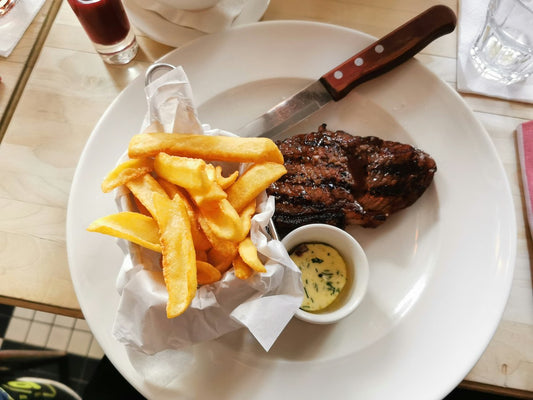Does Tea Expire and How Long Does Tea Last?
Norah Clark
The shelf life of tea varies based on the type. Typically, black and green teas last 18-24 months, while herbal teas can last up to 36 months if stored in a cool, dry place in an airtight container.
Tea is a popular beverage enjoyed worldwide – especially here in Ireland! From green and black teas to white and herbal teas, there is a tea flavor for every palate – especially in our tea gift basket selection!
Read on to see a simple guide to the shelf life of different types of tea and my tips for keeping your tea fresh for as long as possible!
How Long Does Tea Last?
The shelf life of tea can vary depending on the type and how it is stored. In general, tea can last for several years if stored properly.
However, the flavor and quality may start to decline over time.
It's worth mentioning that while tea can technically last for longer than the recommended timeframes, the flavor and quality may become less desirable. To fully enjoy the flavors and benefits of tea, it's best to drink it within the suggested shelf life.
Here is a breakdown of the approximate shelf life for different types of tea:
1. Black Tea
Black tea has a longer shelf life compared to other types of tea.
When stored in a cool, dark, and dry place, black tea can maintain its flavor and freshness for up to two years.
After this time, the quality may gradually diminish, but it is still safe to consume.
2. Green Tea
Green tea is known for its delicate flavor and antioxidant properties.
To preserve the freshness of green tea, it is best consumed within six to twelve months of purchase.
However, if properly stored in an airtight container away from heat, light, and moisture, green tea can still be enjoyable for up to two years.
3. White Tea
White tea is the least processed of all teas and has a more subtle flavor.
Like green tea, the optimal shelf life for white tea is approximately six to twelve months.
However, if stored properly, it can be consumed for up to two years without a significant decline in quality.
4. Herbal Tea
Herbal teas are made from various plants and do not contain any actual tea leaves, because of this, herbal teas have a longer shelf life compared to true teas.
When stored in a cool, dry place, herbal teas can last for up to two years.
It's important to note that the taste and potency of herbal teas may gradually diminish over time.
5. Flavored Tea
Flavored teas, such as Earl Grey or Jasmine Green tea, often contain added ingredients like herbs, spices, or natural flavors.
The shelf life of flavored tea can vary depending on the type and quality of ingredients used.
In general, flavored teas can be enjoyed for up to a year if stored properly.
What Can Affect Your Teas Shelf Life
Several factors can impact the shelf life of tea, but once you know them, you can extend the shelf life of your favorite blends and enjoy them to the fullest!
Here are some key factors to consider when storing your tea bags:
1. Storage Conditions
Proper storage is crucial for maintaining the freshness of tea. Tea should be stored in an airtight container to prevent exposure to air, moisture, light, and strong odors.
Avoid storing tea near spices, coffee, or any other strong-smelling substances that could affect its taste.
2. Temperature
Tea should be kept away from heat sources, such as stoves or direct sunlight.
High temperatures can speed up the oxidation process and degrade the flavor and quality of tea.
Aim to store tea in a cool place, ideally below room temperature.
3. Humidity
Moisture can be detrimental to tea, as it can cause mold or spoilage.
It's important to store tea in a dry environment to prevent moisture absorption.
Avoid storing tea in the refrigerator, as condensation can occur when the container is taken in and out of the fridge.
4. Packaging
The packaging of tea can also impact its shelf life. Look for teas that come in resealable bags or airtight containers.
Once opened, make sure to seal the packaging tightly after each use to minimize air exposure.
How To Store Tea To Extend Its Shelf Life
To extend the shelf life of your tea, follow these storage tips:
- Store tea in an airtight container to prevent exposure to air and moisture.
- Keep tea away from heat sources and direct sunlight.
- Avoid storing tea near strong-smelling substances.
- Store tea in a cool, dry place, ideally below room temperature.
FAQs
Can tea go bad?
While tea can technically go bad, it is uncommon. However, the flavor and quality of tea may decline over time. Proper storage can help prolong the freshness of tea and ensure a better taste.
How can I tell if my tea has gone bad?
Tea that has gone bad may have a sour or musty smell. The color and taste may also be noticeably different. If you notice any of these signs, it's best to discard the tea.
Can expired tea make you sick?
Expired tea, if consumed, is unlikely to make you sick. However, it may not taste very pleasant. If a tea is significantly past its shelf life, it's generally best to avoid drinking it.
Can I drink tea that is past its expiration date?
While it is generally safe to consume tea that is past its expiration date, the flavor and quality may have significantly declined. It's best to use your judgment and discard any tea that seems off or has an unpleasant taste or smell.
Summary
Tea is a versatile and enjoyable beverage with a substantial shelf life if stored properly. Once you know the recommended shelf life for different types of tea and following proper storage practices, you can ensure that your tea remains flavorful and fresh for an extended period.
Whether you prefer black, green, white, or herbal tea, a well-maintained tea stash can provide you with a delightful cuppa for years to come.










